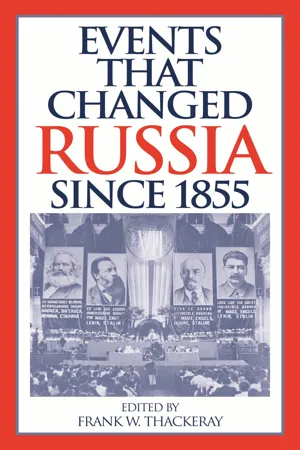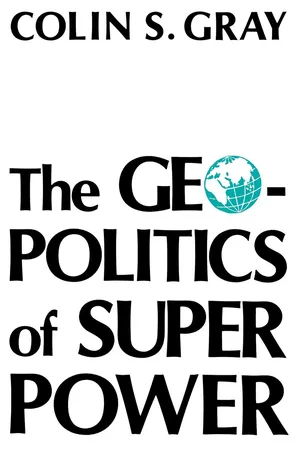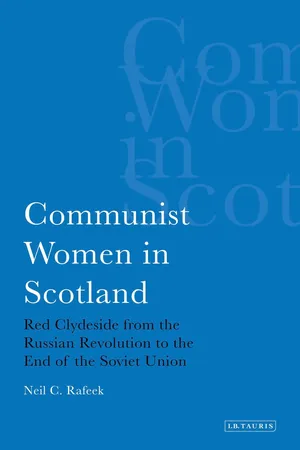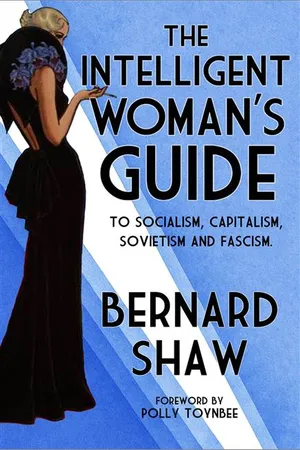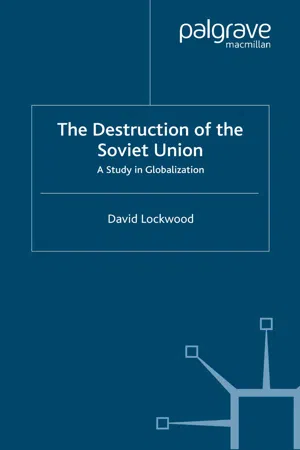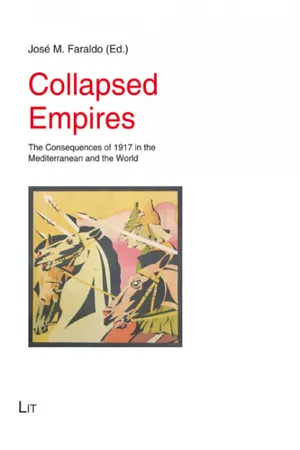History
Soviet Union
The Soviet Union was a socialist state that existed from 1922 to 1991, encompassing a vast territory in Eastern Europe and Asia. It was founded after the Russian Revolution and was characterized by a centralized government, state ownership of the economy, and a one-party system dominated by the Communist Party. The Soviet Union played a major role in shaping global politics and was a key player in the Cold War.
Written by Perlego with AI-assistance
Related key terms
1 of 5
6 Key excerpts on "Soviet Union"
- eBook - PDF
- Frank W. Thackeray(Author)
- 2007(Publication Date)
- Greenwood(Publisher)
Frequently, they featured panegyrics about party leaders past and present. The discrepancies between theory and reality also demoralized many Soviets. The fundamental principle of Marxism-Leninism is collectivism; yet, as in George Orwell’s Animal Farm, it was painfully obvious that some Soviets were “more equal” than others. Party membership bestowed a range of perks that ordinary citizens could only dream about. Furthermore, corruption was rampant, and men and women on the take filled the ranks of the ubiquitous, unmovable bureaucracy. Bribery was an accepted way of life. Finally, a seemingly unquenchable thirst for vodka gave rise to a nation of unproductive, sickly alcoholics. Beyond unhappy individuals, large groups also resented the status quo. The Soviet Union was a multinational state composed of well over 100 different nationalities. Soviet leaders had labored to destroy traditional national sentiments and to substitute in their place a loyalty to the Soviet Union, but a number of these nationalities yearned to be free. They included Estonians, Latvians, and Lithuanians, who were violently incorporated into the Soviet Union in 1940, and Ukrainians, who in 1980 totaled 43 million, or about 16 percent of the entire population. Globally, the Soviet Union also faced serious challenges, the most im- portant being a determined Western alliance led by the United States. In comparison with the Soviet Union, the West was wealthier, more populous, more economically vibrant, and more militarily advanced. Furthermore, it practiced containment, pledging to resist global Communist expansion. In competing with the West, the Soviet Union had badly overextended itself during the 1960s and 1970s. It simply lacked the resources necessary to retain its global position in places such as Africa and Latin America. - eBook - PDF
- Colin S. Gray(Author)
- 2014(Publication Date)
- The University Press of Kentucky(Publisher)
The Course of Soviet Empire 105 emphasized the idiocy of rural life, yet his self-proclaimed disciples seized power in a country that was economically and socially dominated by rural life. The idea of an isolated bastion of socialism, let alone an isolated bastion dominated economically by agriculture, should be heresy to anyone at all faithful to the writings of Marx. 35 The shotgun marriage, effected in 1917 and consolidated in the culture of War Communism, 36 between the most backward of the industrializing countries and socialist theory necessarily resulted in a political system that was far more Russian than it was socialist. Nevertheless, in the universalistic terms of formal Soviet ideology, the Soviet Union is still the vanguard of the transnational worldwide proletariat, assisting the world-historical process of change from feudal-ism to bourgeois capitalism to imperialism to socialism. 37 As such, by reason both of ideological necessity for domestic legitimacy and of geopo-litical assessment, the Soviet Union is committed to the waging of political warfare against the United States. Whatever the true blend of ideology and Realpolitik, the objectives of Soviet security policy can be described in specific geopolitical terms with some confidence. Soviet leaders may well believe that they will have to fight the United States one day. The principal reason, in likely Soviet assessment, is that the United States will come to recognize that it is losing the protracted struggle for power and influence; in that context some American govern-ment may be tempted to roll the dice to see whether a bold, adventurist military stroke can snatch rapid victory from the jaws of slowly unfolding defeat. If this assessment of Soviet reasoning has any merit, one may be certain that the Soviet Union will bend every effort to achieve political— and if not political, then strategic—warning of an American attack. - eBook - PDF
Communist Women in Scotland
Red Clydeside from the Russian Revolution to the End of the Soviet Union
- Neil C. Rafeek(Author)
- 2008(Publication Date)
- I.B. Tauris(Publisher)
Chapter 5 Solidarity with the Socialist World: The Soviet Union and the Eastern Bloc, 1917–64 I thought we all looked up to the Soviet Union. It was the first country in the world that threw the capitalists off their backs, so we had to look up to it. It was important. 1 The USSR 1917–45 The Russian Revolution and the fight to retain the new republic in the first few years shaped the consciousness of many party members and determined at times a fiercely loyal, albeit uncritical, attitude to future events. After the ‘war on 23 fronts’ 2 with countries and internal opposition hostile to the Soviet republic came the years of famine and the economic restraints on trade that made it seem doubtful if the revolution could survive. That the Soviet Union did survive such open hostility no doubt coloured party members in supporting measures of dubious legitimacy. In this chapter I attempt to set out and explain the attitude of women party members in Scotland to the Soviet Union and their experiences and perceptions, including the dramatic and for some traumatic events of 1956. More than three-quarters of the women I interviewed had visited one or more socialist country and, more often than not, the Soviet Union was prioritized. The history of the USSR was tied up with its affiliated parties. Most gave unquestioning allegiance to the CPSU through the Communist International. Lenin’s legacy and, from the mid-1920s, Stalin’s dominance were seen as central to world socialism. Many workers had acted in inter-national solidarity before the appearance of communist parties: ‘It was the first country that had been taken over by the workers and everybody looked towards the Soviet Union for leadership because it was the first SOLIDARITY WITH THE SOCIALIST WORLD 123 workers’ republic. - eBook - PDF
- (Author)
- 2018(Publication Date)
- Alma Classics(Publisher)
471 84. sovietism 84. Sovietism In the ten years that have passed since this book was written an extraor-dinary event has put its precepts to a severe practical test. The vastest single State in the world, covering a sixth of the earth’s surface, with a growing population of more than 175 millions, has thrown over Capitalism and substituted Communism as its policy and principle. Its prophet is Karl Marx, whose works were its textbooks and its gospel. Our British post-Marxian literature of Socialism was either unknown or disregarded; and this book was unwritten. The first results were appalling. The change took place in 1917; and by 1920 the condition of the former Russian Empire, now called the USSR (Union of Soviet Socialist Republics), was so desperate that it seemed to be a warning to the whole world against the alleged wick-edness and impossibility of Socialism. Yet now, nearly twenty years later, Russia is an example to all the world of the enormous superiority of Socialism to Capitalism economically, socially and politically. And this is not through the skilful administration and business capacity of her very able and devoted leaders, but in spite of every mistake their inexperience could possibly make, and every folly their technically uninstructed idealism could tempt them to. Their ineptitude seems more disastrous than it really was, because, instead of hushing up their blunders and hoodwinking the people as the Capitalist practice is, they were their own most vociferous and derisive critics, and had no sooner found out their errors than they shouted the news from every loudspeaker in the country, and changed their course or even went full speed astern with a promptitude inconceivable by our House of Commons, which would have taken many years to make much smaller changes and in the end only pretend to make them. - eBook - PDF
The Destruction of the Soviet Union
A Study in Globalization
- D. Lockwood(Author)
- 2015(Publication Date)
- Palgrave Macmillan(Publisher)
The civil war, and the wars of intervention that followed it made necessary the rapid construction of a functioning war economy. The new Soviet state consequently assumed a huge role in that economy and soon shouldered aside all other economic actors. This was the period of ‘war communism’ – of desperate measures and military 64 The Destruction of the Soviet Union methods. Paradoxically, it was a period of great optimism for many Bolsheviks who believed that the increasing role of the Soviet state and the forced egalitarianism of the war economy was creating socialism before their very eyes. After all, was not state capitalism under a revo- lutionary goverment more than halfway to socialism? Partly because of this, and partly in order to bolster enthusiasm for the new regime, the Bolshevik leaders themselves were soon throwing caution to the winds and speculating not only on the possibility of Russian socialism – but sooner rather than later. Trotsky reports that Lenin was of the belief that ‘in six months we were going to have socialism and become the most powerful state’. Lenin told a joint session of the Central Executive Committee (CEC) and the Trade Union Congress in January 1919 that the formation of ‘Poor Peasant Committees’ represented the crossing of the boundary dividing the bourgeois from the socialist revolution. The programme of the Russian Communist Party declared in March 1919 that ‘the dictatorship of the proletariat’ which had issued from the October Revolution, had begun to build ‘the foundations of communist society’. ‘The Soviet state’ declared the Ninth Party Congress in March/April 1920, ‘is in practice building communism ...’. - eBook - PDF
- José M. Faraldo(Author)
- 2020(Publication Date)
- LIT Verlag(Publisher)
The Soviet Collapse 25 learned to withhold information from their superiors when doing so protected their personal interests. Their superiors not only looked the other way as long as formal economic targets were being met, but also had no way of knowing which information was being withheld from them. Bureaucrats in USSR had, prior to Gorbachev’s reforms, relative freedom of maneuver because controls on bu- reaucrats in Soviet organizations were weak. State and economic capacity re- quired a certain degree of state incapacity: of the inability of Party organiza- tions, and state ministries to extract accurate information about the way the different parts of the system were functioning on the “street level.” As a result, Party and state cadres acquired a “trained capacity” for acting in ways that de- fied the formal system of hierarchy and authority, and for promoting their self- interest at the expense of the “collective.” 53 It might well be, as Steven Solnick has put it, that “[w]ell before the 1980s, ideology had ceased to be the mortar holding that edifice [the Soviet system] together.” 54 But whether or not this was the case, Soviet cadres lived an everyday contradiction between Marxism- Leninism’s formal assertion of the subordination of the individual to collective interests, and their own selective subordination of collective to individual inter- ests. The Soviet Ancien Régime in Crisis, 1986-Late 1988 The Soviet social revolution was a process that began in 1986 when CPSU General Secretary Mikhail Gorbachev launched reforms that inadvertently led to the breakdown of the Soviet system and the unravelling of the Soviet Un- ion.
Index pages curate the most relevant extracts from our library of academic textbooks. They’ve been created using an in-house natural language model (NLM), each adding context and meaning to key research topics.
